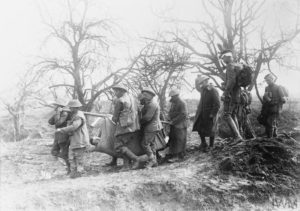Sunday July 21st, 1918
Seventh day defaulters. Reveille 5:30. Packed up for moving. Pounds of Bully & Jam dumped – yet for eating one and three quarter pound tin – we get 14 days CB [Confined to Barracks]. That’s the British Army. Coolish morning. Left Abancourt 10am for new camp in fruit orchard. Fine ground. Haudricourt.
Moving Camp
After days of being squeezed in between two other Battalions at Abancourt, the 13th is on the move. It is relocating to a new campsite in an orchard in Haudricourt, a short distance away. Both the powers that be and Frank like the site.
Frank is still on extra fatigues and confined to camp for stealing and eating, with some comrades, a 1¾ lb tin of Bully Beef. Today he is outraged that both Bully Beef and jam are being dumped at the old camp rather than moved with the Battalion. ‘That’s the British Army!’ he writes.
All Change
The 13th Battalion of the Manchester Regiment, part of 66th Brigade of the 22nd Division of XII Corps of the British Salonika Force since November 1915 , has changed its reporting line. Today it becomes the 13th Battalion of the 199th (Manchester) Brigade within the 66th (2nd East Lancashire) Division of the XIX Corps of the 5th Army, British Expeditionary Force.º
66th (2nd East Lancashire) Division
At the outbreak of war, the Territorials in Lancashire were split into two divisions. Those troops available for overseas service formed the 1st unit (42nd East Lancashire Division) and were sent to Egypt in September 1914. Those identified for home service (the 2nd line unit) were put under the command of 2nd East Lancashire Division for national defence and as the reserve. As such they took on a lot of new recruits, drawn from across Lancashire. In the face of manpower shortages, in early 1917, the 2nd East Lancashire embarked for France.

Originally comprising 197th (Lancashire Fusiliers), 198th (East Lancashire) and 199th (Manchester) Brigades, the 66th Division was involved in preparations for the abandoned Operation Hush (June – September 1917) and then saw active service at the Third Battles of the Ypres (October 1917).¹
The following year it was involved in the Battles of St Quentin and Rosières in late March 1918, the Allied defence against Germany’s Spring Offensive. As such, all three Brigades suffered very heavy casualties. Within 10 days the front line strength of the Division was reduced to 1200. Over 700 had been killed, a thousand wounded and two thousand taken prisoner. It had lost two of its three Brigade, and 8 of its 12 Battalion, commanders.²
The photograph shows British prisoners near Origny at the Battle of St Quentin in March 1918. They are carrying a wounded comrade in an improvised stretcher.*
For months the Division was reduced to training cadres (10 officers and 45 men per Battalion) who worked in May and June with American troops. Under the young, mercurial and sometimes unpopular commander Hugh Keppel Bethell, the Brigade would then be reformed and reconstituted.²
13th (Service) Battalion War Diary – 21st July 1918 – Haudricourt, France
Sunday. Battalion left camp 09:40 hrs arriving Haudricourt 12:00 hrs. Transport supplemented by motor lorries. New camp pleasantly situated in an orchard with good turf. Battalion now belongs to 199th Brigade in 66th Division. Brigadier General Williams. Other units in the Brigade are 12th Lancashire Fusiliers and 5th Royal Irish Fusiliers.
References & Further Reading
º The 66th will move again before the 100 Day Offensive and become part of Rawlinson’s 4th Army.
¹ Regiments on The Long Long Trail (various articles)
² 66th Division on Wikipedia
* Q 29927, copyright Imperial War Museums



One thought on “66th Division – July 21st, 1918”
Comments are closed.